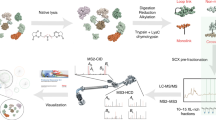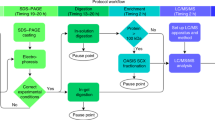Abstract
Various endogenous and exogenous agents drive the un-directed formation of covalent bonds between proteins and DNA. These complex molecules are of great biological relevance, as can derive in mutations, but are difficult to study because of their heterogeneous chemical properties. New analytical approaches with sufficient detection capabilities to detect and quantify these compounds can help to standardize study models based on synthesized standards. The use of atomic spectrometry can provide quantitative information on the DNA-protein cross-link reaction yield along with basic stoichiometry of the products, based on internal elemental tags, sulfur from Cys and Met amino acids, and phosphorus from the DNA. A new instrumental approach to remove isobaric and polyatomic interferences from 31P+ and 32S+ was developed recently, with state-of-the-art for interference removal that captures 31P+ in Q1; it reacts with O2 in an octopole collision-reaction cell generating 47PO+, therefore allowing detection in Q3 without 31NOH+/48Ca/47Ti interferences. Similarly, 32S+ is reacted to 48SO+, eliminating the polyatomic interferences at m/z = 32. In conjunction with the high resolving power of high-performance liquid chromatography (HPLC), this newer technology was applied by to the product purification of a DNA-protein cross link model and some preliminary structural studies.



Similar content being viewed by others
References
Ide H, Shoulkamy MI, Nakano T, Miyamoto-Matsubara M, Salem AMH (2011) Repair and biochemical effects of DNA–protein crosslinks. Mut Res Fundam Mol Mech Mutagen 711(1–2):113–122. doi:10.1016/j.mrfmmm.2010.12.007
Barker S, Weinfeld M, Murray D (2005) DNA–protein crosslinks: their induction, repair, and biological consequences. Mutat Res Rev Mutat Res 589(2):111–135. doi:10.1016/j.mrrev.2004.11.003
Costa M, Zhitkovich A, Harris M, Paustenbach D, Gargas M (1997) DNA-protein cross-links produced by various chemicals in cultured human lymphoma cells. J Toxicol Environ Health 50(5):433–449. doi:10.1080/00984109708984000
Zwelling LA, Anderson T, Kohn KW (1979) DNA-protein and DNA interstrand cross-linking by cis- and trans-platinum(II) diamminedichloride in L1210 mouse leukemia cells and relation to cytotoxicity. Cancer Res 39(2 Pt 1):365–369
Chiu SM, Friedman LR, Sokany NM, Xue LY, Oleinick NL (1986) Nuclear matrix proteins are crosslinked to transcriptionally active gene sequences by ionizing radiation. Radiat Res 107(1):24–38
Zhitkovich A, Costa M (1992) A simple, sensitive assay to detect DNA–protein cromlinks in intact cells and in vivo. Carcinogenesis 13(8):1485–1489
Merk O, Speit G (1999) Detection of crosslinks with the comet assay in relationship to genotoxicity and cytotoxicity. Environ Mol Mutagen 33(2):167–172. doi:10.1002/(SICI)1098-2280(1999)33:2<167::AID-EM9>3.0.CO;2-D
Zhuang Z, Costa M (1994) Development of an 125I-postlabeling assay as a simple, rapid, and sensitive index of DNA-protein cross-links. Environ Health Perspect 102(Suppl 3):301–304
Shoulkamy MI, Nakano T, Ohshima M, Hirayama R, Uzawa A, Furusawa Y, Ide H (2012) Detection of DNA-protein crosslinks (DPCs) by novel direct fluorescence labeling methods: distinct stabilities of aldehyde and radiation-induced DPCs. Nucleic Acids Res 40(18):e143. doi:10.1093/nar/gks601
Bandura DR, Baranov VI, Tanner SD (2002) Detection of ultratrace phosphorus and sulfur by quadrupole ICPMS with dynamic reaction cell. Anal Chem 74(7):1497–1502. doi:10.1021/ac011031v
Balcaen L, Woods G, Resano M, Vanhaecke F (2013) Accurate determination of S in organic matrices using isotope dilution ICP-MS/MS. J Anal At Spectrom 28(1):33–39. doi:10.1039/c2ja30265a
Fernández SD, Sugishama N, Encinar JR, Sanz-Medel A (2012) Triple Quad ICPMS (ICPQQQ) as a new tool for absolute quantitative proteomics and phosphoproteomics. Anal Chem 84(14):5851–5857. doi:10.1021/ac3009516
Evans EH, Wolff J-C, Eckers C (2001) Sulfur-specific detection of impurities in cimetidine drug substance using liquid chromatography coupled to high resolution inductively coupled plasma mass spectrometry and electrospray mass spectrometry. Anal Chem 73(19):4722–4728. doi:10.1021/ac0103017
Acknowledgments
The authors wish to thank Agilent Technologies for the loan of an Agilent Technologies 8800, ICP-MS/MS.
Author information
Authors and Affiliations
Corresponding author
Additional information
Published in the topical collection Spectrochemical Plasmas for Clinical and Biochemical Analysis with guest editors Alfredo Sanz-Medel and María Montes Bayón.
Rights and permissions
About this article
Cite this article
Gong, J., Solivio, M.J., Merino, E.J. et al. Developing ICP-MS/MS for the detection and determination of synthetic DNA-protein crosslink models via phosphorus and sulfur detection. Anal Bioanal Chem 407, 2433–2437 (2015). https://doi.org/10.1007/s00216-015-8504-x
Received:
Revised:
Accepted:
Published:
Issue Date:
DOI: https://doi.org/10.1007/s00216-015-8504-x




